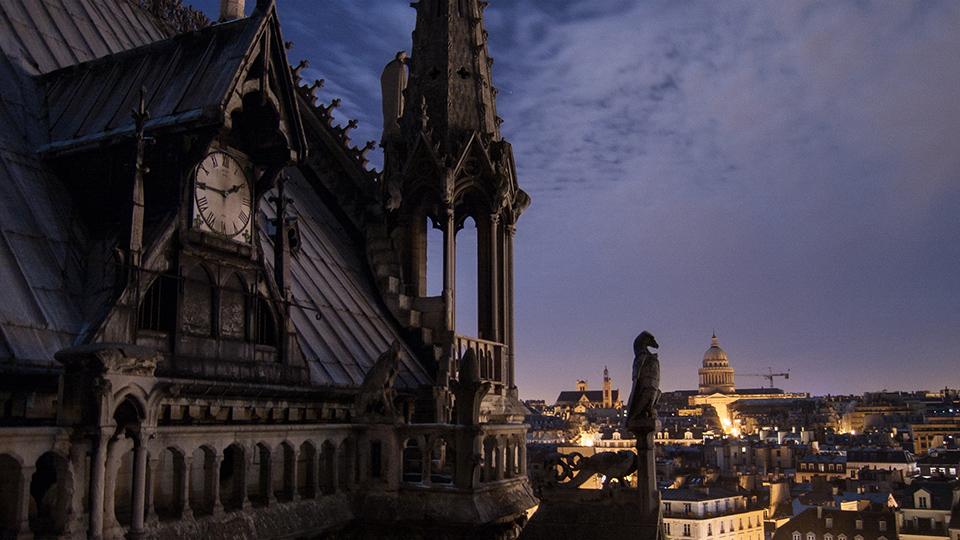Notre-Dame: Why do we feel intense loss?
Primary page content
A devastating fire at Notre-Dame, Paris, on Monday 15 April 2019 destroyed much of the Gothic cathedral’s roof and led to the collapse of its iconic spire.

Notre-Dame at night - photograph by Édouard Bergé (CC BY-SA 4.0)
As the fire burned there was an outpouring of grief around the world, and in the two days since, some £700m in international donations has been pledged for reconstruction, reflecting the love and connection so many people have for the building.
Dr Rotem Perach is a social psychology researcher and Teaching Fellow in the Department of Psychology. His research interests include the psychological functions of cultural legacy, cultural symbols of motherhood, and creative achievement.
I asked him about the role of cultural symbols and the psychological impact their accidental or deliberate destruction has on communities.
Sarah Cox: How would you define a ‘cultural symbol’ and why are they important?
Rotem Perach: From the poppy pin, through to adverts showing perfectly-loving pregnant women, to recycling icons on green bins, cultural symbols are all around us. They can be seen as constructs that hold shared meanings among members of a social group. These symbols are used to manage everyday life and to communicate cultural beliefs and values that are passed on from generation to generation.
Notre-Dame has been an important cultural symbol in France for centuries. It’s a Catholic cathedral but its significance goes beyond its religious meanings: it is a monument that represents great creative achievement in architecture and art. It is a symbol of humans’ creativity, or more specifically, the ability to produce a long-lasting testament of existence that will outlive its creator and will maintain its cultural value through the centuries. In this sense, Notre-Dame is representative of a successful endeavour to fulfil one of the old human desires: to beat death.
SC: What impact does the destruction of a cultural symbol have?
RP: When cultural symbols are destroyed, people can become upset and distraught. In many countries punitive laws are set to prevent the inappropriate use or destruction of cultural symbols (such as the national flag). While such laws may help to maintain the public’s sense of symbolic security conferred by cultural symbols (“The British pound is strong!”), the destruction of cultural symbols is unfortunately not a new occurrence in this century. For example, in 2015 Islamic State militants destroyed multiple ancient monuments in Iraqi sites to the condemnation of officials worldwide.
SC: How can we explain such an outpouring of grief over a physical site, when there is no loss of life?
RP: When a valued physical site is destroyed, people may be affected by its loss for many reasons – they may have loved its beauty, enjoyed visiting it as children and adults, or on a more concrete level, lament the expected economic costs of renewal. Nonetheless, it is the threat to the symbolic properties that the site represented that may engender a sense of anxiety and affect people’s behaviours.
In an attempt to manage the cultural loss and the consequent anxiety, people may be motivated to re-affirm their cultural worldviews, that is, try to ensure that one’s cultural world makes sense again. This can be achieved by changing self-perceptions or by engaging in various behaviours. For example, huge displays of public grief that are often witnessed after cultural losses can be seen as a way to reinstate a sense of connectedness with one’s culture and its values.
SC: What impact might this have on people in the long-term?
RP: In the political domain, people’s perceptions and behaviours may be affected by cultural losses. In the psychological aftermath of the Notre-Dame fire, depending on various factors, people may cling more strongly to their political worldviews (whether liberal or conservative) or shift towards a more conservative political position. Macron’s statement on his commitment to rebuilding the Notre-Dame “together”, as a part of the “French destiny” seems to acknowledge the psychological importance of this tragedy, effectively framing it in terms of solidarity that are unlikely to be contested across the political spectrum at this moment.